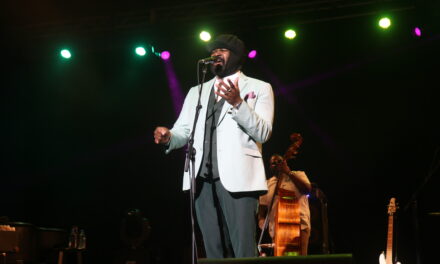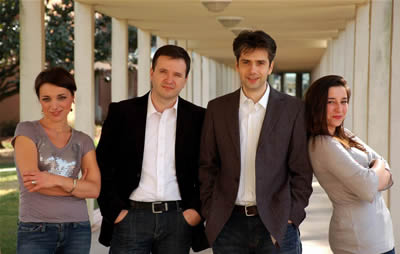Some old favorites from the chamber music repertoire shared the stage with more recent, less-often-performed works at the first Next Generation concert of the Four Seasons Chamber Music Festival‘s 2013-14 season. The old favorites were portions of chamber works by Brahms, Dvořák, and Tchaikovsky, along with a Vivaldi concerto; the newer pieces that opened and closed the concert were by Shostakovich and Britten. The combination of East Carolina University string students, string faculty, and guest performers delivered an afternoon of splendid music-making.
The third and fourth movements from Brahms’ Piano Quintet in F-minor, Op. 34, with its familiar grand melody in the scherzo, received a warm reading from Four Seasons artistic director Ara Gregorian, viola, faculty violinist Hye-Jin Kim, faculty pianist Keiko Sekino, and student violinist Mary Catherine Cox and student cellist Logan Dailey. These two sections represent more muscular Brahms than we often hear. The sections for full ensemble are quite full-bodied, not for the faint of heart, while the occasionally more intimate sections – such as the piano-cello duet in the scherzo and the duet and trio passages in the fourth finale: poco sostenuto section – are delicate by contrast but still do not lose their forward drive. Sekino provided fine keyboard playing throughout, whether leading or accompanying, and Cox and Dailey acquitted themselves well, including in the furious conclusion.
The allegro non tanto movement from Dvořák’s String Quintet No. 3 in E-flat, Op. 97, combined Gregorian (viola) and guest violinist Xiao-Dong Wang of Concertante with students Johnathan Spence, violin, Marta Lambert, viola, and C.J. Collins, cello. Lambert’s warm, rich tone was a highlight of the entire program, and Collins’ cello playing was exemplary as well. On occasion, the movement faintly echoes phrases in the “American” String Quartet (this quintet and the famous quartet both were written while Dvořák was in America); the feel is one of Bohemian-Eastern European dance or folk melodies, with engagingly vivacious rhythms and harmonies.
The program also included the opening allegro con spirito movement of Tchaikovsky’s String Sextet in D-minor, Op. 70, called “Souvenir de Florence”; it received a lushly romantic reading, full of energy and passion. Wang’s solo violin line at the beginning had a lovely singing tone, and he provided outstanding leads throughout the piece. His exchanges with student violist Benjamin Smith and Gregorian (viola) were highlights. ECU alumnus and cellist Randy Ward, who now teaches in Northern Virginia, joined the ensemble.
One of the three larger-scale works on the program was Vivaldi’s Concerto for Four Violins in B-minor, RV 580, for which Wang, Gregorian, and Kim were joined by Amelia Dietrich as the soloists, accompanied by nearly 20 students and faculty members. The opening allegro movement, which sounds as if it could have been part of a Four Seasons concerto, gives each of the soloists a chance to lead, and Dietrich handled her part with skill and precision. There were also passages for violin duets and trios against the full ensemble. The concerto is brief but lively, and the strings sounded quite good from start to finish.
The program opened with Shostakovich’s Prelude and Scherzo for String Octet, Op. 11, a challenging work for both performers and audience. This is a dark, somber piece at the outset, with some strange string sounds, but before it ends, it becomes a harsh musical statement, filled with nervous energy and near-cacophonous scoring. In the first section, Gregorian played a demanding solo line as the lead violinist, displaying great intensity and skill. Cellist Emanuel Gruber had an emotional solo line at the opening of the second section, infused with great sadness, played over plucked strings that sounded almost like raindrops. The four students in the octet handled their parts well.
The concert closed with Benjamin Britten’s Simple Symphony, Op. 4, a delightful piece encompassing all the performers. This is tuneful early Britten, a grand composition for string orchestra. The most familiar section, the “Playful Pizzicato,” was wonderful, with fine fingering that produced a firm musical sound without straying into something that could have resembled a group of banjos. The third “Sentimental Sarabande” movement was the emotional highlight of the entire concert, a slow, lush, melancholy piece that included particularly fine playing by the violas over a soft cushion of support by the violins.
We have come to expect performances of the highest quality from the professionals who play at regular Four Seasons concerts. Gregorian and the other ECU string faculty members also are producing highly skilled students who have shown in these Next Generation concerts that they have a passion for playing and can hold their own with their teachers and contribute to performances of similar high quality.












